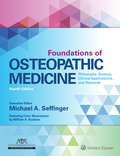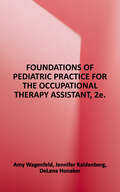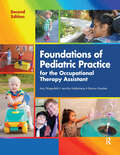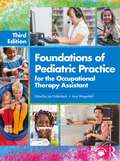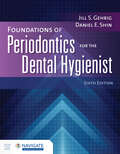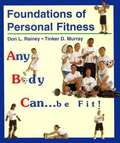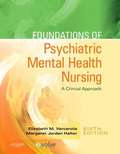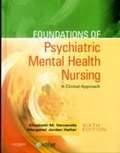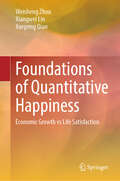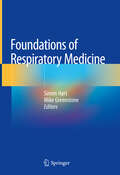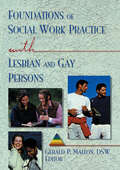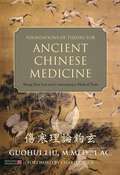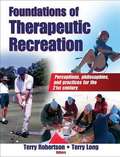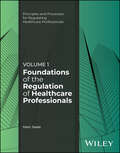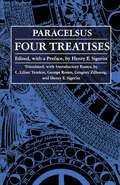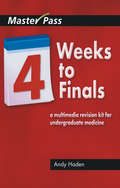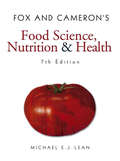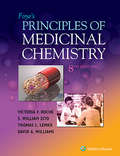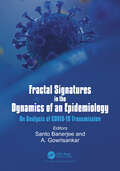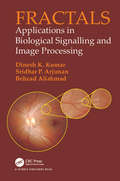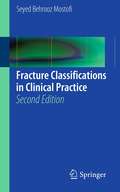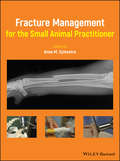- Table View
- List View
Foundations of Osteopathic Medicine: Philosophy, Science, Clinical Applications, and Research
by Michael SeffingerPublisher's Note: Products purchased from 3rd Party sellers are not guaranteed by the Publisher for quality, authenticity, or access to any online entitlements included with the product. The most current, comprehensive osteopathic text available, Foundations of Osteopathic Medicine, Fourth Edition, defines osteopathic terminology and techniques and instills the confident understanding essential to clinical success. This proven resource is the standard text for teaching the osteopathic profession, providing broad, multidisciplinary coverage of osteopathic considerations in the basic sciences, behavioral sciences, family practice and primary care, and the clinical specialties. Endorsed by the American Osteopathic Association, this popular text makes the key tenets of osteopathic practice more accessible than ever and demonstrates a wide variety of osteopathic manipulative methods in vivid detail. More than half of this new edition is made up of all-new content, reflecting current practices in basic sciences foundation, the osteopathic approach to patient care, somatic dysfunction and treatment, osteopathic considerations in the specialties, and research investigating osteopathic principles. New illustrations and a full-color design bring concepts to life, and enhanced pedagogical features make the entire text easier to use for students and practitioners alike.
Foundations of Pediatric Practice for the Occupational Therapy Assistant
by Amy Wagenfeld Jennifer Kaldenberg DeLana HonakerFoundations of Pediatric Practice for the Occupational Therapy Assistant, Second Edition delivers essential information for occupational therapy assistant students and practitioners in a succinct and straightforward format. In collaboration with a wide range of highly skilled and expert professionals from clinical practice and academia, Amy Wagenfeld, Jennifer Kaldenberg, and DeLana Honaker present an interprofessional perspective on pediatric clinical foundations, theory, and practical application activities in a highly accessible and engaging format. The Second Edition of Foundations of Pediatric Practice for the Occupational Therapy Assistant offers new and engaging features, including diverse illustrations, to facilitate learning from the classroom to the clinic. Integrated within each chapter are Stories From Practice: brief vignettes of actual author clinical experiences, short case studies, and reflective activities designed to elicit discussion and exploration into the unique world of pediatric occupational therapy theory and practice. A new chapter on childhood trauma has been added to enhance the comprehensive and current nature of pediatric practice in the 21st century. Available online is a significant Major Infant Reflexes Chart and a comprehensive Normal Developmental Milestones Chart that will reinforce important concepts associated with child development as it relates to occupational therapy assistant practice. The seamless integration of this material enables all readers to develop a comprehensive understanding of the information and apply that knowledge in a pediatric setting. Features of the Second Edition: - Up-to-date information, including the AOTA's current Occupational TherapyCode of Ethics - Stories From Practice feature, which provides a unique reflective link from classroom to clinic - Useful resources for classroom to clinical practice - Bonus website that provides a comprehensive Normal Developmental Milestones Chart and Major Infants Reflexes Chart - Chapter on childhood trauma Instructors in educational settings can visit www.efacultylounge.com for additional material to be used for teaching in the classroom. Foundations of Pediatric Practice for the Occupational Therapy Assistant, Second Edition continues to be the perfect text for both occupational therapy assistant students and practitioners specializing in or transitioning to pediatrics.
Foundations of Pediatric Practice for the Occupational Therapy Assistant
by Amy Wagenfeld Jennifer Kaldenberg DeLana HonakerFoundations of Pediatric Practice for the Occupational Therapy Assistant, Second Edition delivers essential information for occupational therapy assistant students and practitioners in a succinct and straightforward format. In collaboration with a wide range of highly skilled and expert professionals from clinical practice and academia, Amy Wagenfeld, Jennifer Kaldenberg, and DeLana Honaker present an interprofessional perspective to pediatric clinical foundations, theory, and practical application activities in a highly accessible and engaging format.The Second Edition of Foundations of Pediatric Practice for the Occupational Therapy Assistant offers new and engaging features, including diverse illustrations, to facilitate learning from the classroom to the clinic. Integrated within each chapter are Stories From Practice: brief vignettes of actual author clinical experiences, short case studies, and reflective activities designed to elicit discussion and exploration into the unique world of pediatric occupational therapy theory and practice. A new chapter on childhood trauma has been added to enhance the comprehensive and current nature of pediatric practice in the 21st century.Available online is a significant Major Infant Reflexes Chart and a comprehensive Normal Developmental Milestones Chart that will reinforce important concepts associated with child development as it relates to occupational therapy assistant practice. The seamless integration of this material enables all readers to develop a comprehensive understanding of the information and apply that knowledge in a pediatric setting.Features of the Second Edition: Up-to-date information, including the AOTA’s current Occupational TherapyCode of Ethics Stories From Practice feature, which provides a unique reflective link from classroom to clinic Useful resources for classroom to clinical practice Bonus website that provides a comprehensive Normal Developmental Milestones Chart and Major Infants Reflexes Chart Chapter on childhood trauma Included with the text are online supplemental materials for faculty use in the classroom. Foundations of Pediatric Practice for the Occupational Therapy Assistant, Second Edition continues to be the perfect text for both occupational therapy assistant students and practitioners specializing in or transitioning to pediatrics.
Foundations of Pediatric Practice for the Occupational Therapy Assistant
by Amy Wagenfeld Jan HollenbeckThis best-selling text provides an essential introduction to the theoretical foundations to clinical pediatric care within occupational therapy, as well as illustrative guidance to inform its practical application for occupational therapy assistants.This new edition has been thoroughly updated to include new chapters on autism and trauma responsive care, and with a greater overall emphasis on occupational performance and participation. The book aligns with the fourth edition of the OT Practice Framework, as well as the AOTA 2020 Code of Ethics. Written in a succinct and straightforward style throughout, each chapter features brief vignettes drawn on the authors' own clinical experiences, case studies, and reflective activities designed to elicit discussion and exploration into the unique world of pediatric occupational therapy theory and practice. This edition also includes a new feature, ‘In My Words’, charting the experiences of caregivers and children themselves.Including chapters from some of the leading practitioners in the field, and featuring color photos throughout, this will be a key resource for any occupational therapy assistant student or practitioner working with children and their caregivers.
Foundations of Periodontics for the Dental Hygienist with Navigate Advantage Access
by Jill S. Gehrig Daniel E. ShinWith a comprehensive and student-friendly format, Foundations of Periodontics for the Dental Hygienist, Sixth Edition equips dental hygiene students with modern, evidence-based coverage of periodontal anatomy, the periodontal disease process, and classification of periodontal disease. Using an easy-to-follow, detailed outline format, leading experts in the field provide readers with an accessible account of the complex subject of periodontics. Rich with engaging features and student resources, the Sixth Edition has been revised and updated throughout to reflect the hygienist's increasingly important role in periodontal therapy, while detailing how students can confidently apply what they have learned to clinical patient care.
Foundations of Personal Fitness: Any Body Can... Be Fit!
by Don L. Rainey Tinker D. MurrayThe book discusses the foundations of physical fitness, the benefits of regular exercise, and the advantages of weight training and proper nutrition.
Foundations of Psychiatric Mental Health Nursing: A Clinical Approach
by Elizabeth Varcarolis Margaret HalterThe 6th edition of this market-leading textbook offers a clear, straightforward way to understand the often intimidating subject of psychiatric mental health nursing. Its practical, clinical perspective and user-friendly writing style help you quickly master key concepts. Clinical chapters follow the nursing process framework and progress from theory to application with a wealth of real-world examples to prepare you for practice.UNIQUE! A conversational, user-friendly writing style helps you quickly grasp complex psychiatric mental health nursing concepts. Clinical chapters are logically and consistently organized with sections on the clinical picture, epidemiology, comorbidity, etiology, and application of the nursing process. Clinical chapters follow the nursing process, providing you with consistent guidelines for comprehensive assessment and intervention. Vignettes prepare you for real-world practice with personal, descriptive characterizations of patients with specific psychiatric disorders. Coverage of psychopharmacology in clinical chapters familiarizes you with specific drug treatment options, including the most commonly used drugs and important nursing considerations for their use. Assessment Guidelines boxes list essential guidelines for comprehensive patient assessment. Case Studies with Nursing Care Plans present individualized histories of patients with specific psychiatric disorders and include interventions with rationales and evaluation statements for each patient goal. A separate chapter on cultural implications, as well as Considering Culture boxes throughout the text, provides essential information on culture, worldviews, and techniques for providing culturally competent care. Coverage of treatment and recovery in the community addresses the need for successful ongoing psychiatric mental health nursing care in the community setting. A chapter on end-of-life care examines the psychological impact of terminal illness and death on patients, families, and nurses.Updated nursing process and clinical chapters keep you current with the latest ANA Psychiatric-Mental Health Nursing: Scope and Standards of Practice. An increased focus on health promotion and recovery reflects federal, state, and local initiatives to improve screening methods, patient and family teaching, rehabilitation, and community treatment options for people who have mental illnesses. Enhanced Evidence-Based Practice boxes emphasize the profound impact of research-and your potential role in that process-on the advancement of psychiatric treatment options. A new chapter on sleep disorders covers the most common sleep disturbances and their relationships to psychiatric illness, as well as the nurse's role in their assessment and management. A new chapter on sexual dysfunction and sexual disorders examines the complex issue of sexual behavior and provides the information you need to conduct a sexual assessment, identify sexual dysfunctions and disorders, recognize nursing implications, and formulate interventions.
Foundations of Psychiatric Mental Health Nursing: A Clinical Approach (6th Edition)
by Elizabeth M. Varcarolis Margaret Jordan HalterThe 6th edition of this textbook offers a clear, straightforward way to understand the often intimidating subject of psychiatric mental health nursing. Its practical, clinical perspective and user-friendly writing style help you quickly master key concepts. Clinical chapters follow the nursing process framework and progress from theory to application with a wealth of real-world examples to prepare you for practice.
Foundations of Quantitative Happiness: Economic Growth vs Life Satisfaction
by Weisheng Zhou Xuepeng Qian Xiangwei LinThis book is a rarity in that it conducts a comparative study of life satisfaction between Japan and China over a wider area and time period, filling a gap in empirical research on life satisfaction. Unlike many other countries that have focused primarily on the pursuit of economic prosperity, this study objectively examines the relationship between economic growth and life satisfaction. This study examines various aspects of the proportion of individuals who report being satisfied with their lives, including time series and single-year comparisons, as well as the level and rate of economic growth. This study conducted independent questionnaire surveys in China and Japan, analyzed the impact of absolute income and relative income on life satisfaction, and then objectively examined and compared life satisfaction in China and Japan. Furthermore, this study proposes that real disposable income exceeding $8,000 is an important signal of a shift in the pursuit of "spiritual wealth" from an emphasis on "material wealth" among the Chinese and Japanese. In particular, questionnaire surveys, one for all of Japan and one specifically for Kyoto City, were conducted on the impact of the global pandemic COVID-19 on life satisfaction, and it was found that the original "US$8,000" line has risen to "US$15,000". This study not only enriches the understanding of the relationship between economic growth, COVID-19 and life satisfaction, but also provides a new perspective for policy making.
Foundations of Respiratory Medicine
by Simon Hart Mike GreenstoneThis book meets the need for a resource that covers the core knowledge required to pass the SCE exam, which includes the broad field of respiratory medicine. This book is also highly applicable to core medical trainees sitting their MRCP examinations. The format is ideal for effective exam revision with individual chapters covering the key points of each condition in sufficient (but not excessive) detail. Examples of imaging (CXR, CT, PET-CT) are utilised to illustrate cases and descriptions of modern respiratory intervention such as the EBUS/EUS-guided sampling and medical thoracoscopy is included in this essential exam resource.
Foundations of Social Work Practice with Lesbian and Gay Persons
by Gerald P MallonFocusing on the pragmatic aspects of social work with gay and lesbian persons, this book offers a knowledge base of practice that will better prepare students and practitioners for working more competently and effectively with lesbians and gay men. Written by scholars and practitioners in the social work profession, Foundations of Social Work Practice with Lesbian and Gay Persons teaches you how to develop practice approaches that are sensitive to issues of sexual orientation as well as how to work with this population in the contexts of practice with individuals, couples, families, groups, communities, and organizations. The book’s sensible strategies and case studies provide you with critical information that will help you deal with homophobia and heterocentrism and enact a professional commitment to pursuing economic and social equality for diverse and at-risk client populations.A foundation-level text on social work practice with gays and lesbians, this book is designed to provide social work students, academics, and practitioners with an understanding of the values and ethics fundamental to practice with this group of clients. Foundations of Social Work Practice with Lesbian and Gay Persons summarizes the variety of issues, dynamics, and techniques required to work effectively with gay and lesbian clients who are at different points in their development and life cycles. To further help you in your practice, it also discusses: providing skilled professional assistance to gay victims of hate crimes how homophobia can prevent lesbians and gay men from receiving adequate services the obstacles social workers sometimes face when trying to integrate the core set of professional values and ethical principles into their practice practitioner self-disclosure regarding sexual identity developmental milestones for lesbian and gay persons alcohol and substance abuse among lesbians family therapy concepts of fusion and enmeshment same gender socialization assessing issues of sexual expressionCounselors, social workers, and students and academics in gay and lesbian studies will find that Foundations of Social Work Practice with Lesbian and Gay Persons greatly expands the social work knowledge base to disrupt the impact of institutional, individualized, and internal homophobia on social workers, their clients, and the institutions in which social workers practice. Its flexible and creative treatment approaches to therapy with sexual minorities are sure to help you sensitize your therapeutic techniques and improve the quality of care you deliver.
Foundations of Theory for Ancient Chinese Medicine: Shang Han Lun and Contemporary Medical Texts
by Charles Buck Guohui LiuDiscussion of Cold Damage (Shang Han Lun) and contemporary texts of ancient China form the bedrock of modern Chinese medicine practice, yet these classic texts contain many concepts that are either hard to understand or confusing. Based on over thirty years' medical practice, and study of the texts, this book explains the concepts involved so that the clinical applications of the ancient texts can be better understood and put into practice. The author looks at the larger context of ancient Chinese culture and philosophy in terms of theoretical knowledge, scholarly approach, and mindset in order to explain the basis for the medical texts. He also discusses the work of later Chinese medical scholars in elucidating the texts. He then goes on to look at more specific issues, such as the six conformations, zang-fu organ theory, the theory of qi and blood, the theory of qi transformation, and how these are understood in the ancient texts. He also discusses shao yang and tai yang theory; the element of time, and its place in understanding six conformations diseases. This remarkable work of scholarship will clarify many questions about the interpretation of the ancient texts for modern use, and will find a place on the bookshelf of every practitioner of Chinese medicine, as well as on those of scholars of Chinese medicine.
Foundations of Therapeutic Recreation
by Terry Robertson Terry LongFoundations of Therapeutic Recreation provides readers with a comprehensive introduction to the profession. The book draws on the combined wisdom, experience, and technical expertise of 23 professors and leaders in the field. From these contributors, readers gain access to diverse perceptions, philosophies, and practices for therapeutic recreation in the 21st century. The book showcases how the profession addresses various clients' needs throughout the life span through therapeutic programs, modalities, and activities. It also presents a wide range of applications, allowing readers to explore their personal and professional options; provides insight into the basic knowledge, attributes, and skills students need in order to thrive in the field; and delineates career paths in the profession and how a therapeutic recreation specialist works with various populations. Edited by Dr. Terry Robertson and Dr. Terry Long, Foundations of Therapeutic Recreationhas a comprehensive vision. The contributors present the broad scope of therapeutic recreation as research and practice across a diverse demographic of clients and consumers. The contributing authors explore various perspectives on therapeutic recreation and present standards and certification information that prepare students for the profession. Part I defines therapeutic recreation as a profession and provides an overview of its history and of the professional opportunities available. Part I also explores the profession's person-first philosophy and outlines the therapeutic recreation process as well as its models and modalities of practice and its allied professions. Part II delves into trends and issues, looking at demographics, economics, politics, and legislation as they affect the profession. It details international issues and paradoxes and concludes with future perspectives. Part III examines mechanisms for intervention from a number of perspectives, including orthopedic and neurological impairment, developmental disabilities, mental health, youth development, aging, and wellness. Foundations of Therapeutic Recreation contains chapter discussion questions to expand students' learning as well as Outstanding Professionals and Client Portraits sections to help students gain insight into various career paths. The book is accompanied by an instructor guide, PowerPoint presentations, and a test package available via the text's Web site to support the classroom instruction and enhance learning. The entire package gives students a solid grounding in the profession as it is today and a clear understanding of where the profession is headed tomorrow.
Foundations of the Regulation of Healthcare Professionals, Volume 1 (Principles and Processes for Regulating Healthcare Professionals)
by Marc SealeA comprehensive and authoritative reference on the principles and processes for regulating healthcare professionals In Foundations of the Regulation of Healthcare Professionals, renowned international regulator Marc Seale delivers an authoritative discussion on the foundations of the regulation of healthcare professionals, including competence, fitness to practice, professionalism, standards of education, training, and risk, while providing a thorough analysis of how these elements work together and evolve. This comprehensive reference work examines all components of the regulation of healthcare professionals, providing clear definitions and analysis lacking in the existing literature on the subject, and offers a practical guide for understanding a complex regulatory landscape. Readers will also find: A thorough introduction to regulation, risk, and a framework for regulating healthcare professionals Comprehensive explorations of standards, guidance, andsafe and effective practice Practical discussions of how healthcare professionals are regulated A review of the legal principles and processes used to regulate healthcare professionals Perfect for the educators and teachers of healthcare students, Foundations of the Regulation of Healthcare Professionals will also benefit healthcare students, consumer advocacy organisations, healthcare employers, professional associations, lawmakers and regulators.
Four Paws Five Directions: A Guide to Chinese Medicine for Cats and Dogs
by Cheryl Schwartz"Veterinarians and all who want to learn about healing animals cannot be without this landmark book. Dr. Schwartz is to be congratulated for providing new dimensions to the art and science of veterinary medicine and for deriving new meaning from ancient wisdom for the benefit of all sentient beings" -Dr. Michael W. Fox
Four Treatises of Theophrastus Von Hohenheim Called Paracelsus
by ParacelsusFour treatises which illustrate one of the most original minds of the Renaissance at the height of his powers.Born near Einsiedeln in 1493, Philip Theophrastus von Hohenheim, who later called himself Paracelsus, was the son of a physician. His thirst for knowledge led him to study arts in Vienna, then medicine in Italy, but the instruction left him disillusioned. He had learned to see nature with his own eyes, undiluted by the teachings of books. He was a rebellious spirit, hard-headed and stubborn, who travelled all over Europe and the British Isles to practice medicine, study local diseases, and learn from any source he could, humble as it might be. In these years of wanderings, Paracelsus developed his own system of medicine and a philosophy of theology all his own. Though he wrote a great many books that covered a wide range of subjects, only a few of his works were ever published in his lifetime. When he died in Salzburg in 1541, one of the most forceful personalities of the Renaissance died with him. Here are collected four treatises which illustrate four different aspects of Paracelsus' work. The first gives a passionate justification of his character, activities, and views, and gives a picture of the man and his basic ideas. The second treatise is a study of the diseases of miners, with whom Paracelsus had spent a great deal of time. Then follows a treatise on the psychology and psychiatry of Paracelsus. Written at a time when mental diseases were beginning to be studied and treated by physicians, this pioneering essay anticipates a number of modern views. The last essay, entitled "A Book on Nymphs, Sylphs, Pygmies, and Salamanders, and on the Other Spirits," is a fanciful and poetic treatment of paganism and Greek mythology, as well as a good sample of Paracelsus' philosophy and theology. Together these essays show one of the most original minds of the Renaissance at the height of his powers.
Four Umbrellas: A Couple's Journey Into Young-Onset Alzheimer's
by June Hutton Tony WanlessA writing couple searches for answers when Alzheimer's causes one of them to lose the place where stories come from — memory. At the age of fifty-three, Tony walks away from a life of journalism and into an unknown future. June is forty-eight, a writer and teacher, and over the following decade watches as her husband changes — in interests, goals, and behaviour — until Tony has a fall, ending the life they had known. A diagnosis is seven years away, yet the signs of Alzheimer’s are all around. A suitcase Tony packs for a trip is jammed with four umbrellas, a visual symbol of cognitive looping. But how far back do these signs go? The couple starts probing the past and finding answers. This is not an old person’s disease.
Four Weeks to Finals: A Multimedia Revision Kit for Undergraduate Medicine (MasterPass)
by David Wall Andy HadenThis refreshingly readable book with accompanying flash cards is ideal for all undergraduate medical students fast approaching their final exams. Consider your revision methods and contemplate exam psychology. Structure your approach and make those final weeks more bearable. Test yourself with the flash cards and consolidate your knowledge on a wide range of topics. Use them as a guide to perfecting your presentation skills and think logically about each case. Decipher data, practice interpreting x-rays and ECGs, and identify conditions from photos and pictures. This book will teach you mnemonics to help you remember the more intricate causes of certain conditions, offering invaluable support in the run up to your finals. .
Fox and Cameron's Food Science, Nutrition & Health
by Michael EJ LeanThe seventh edition of this classic book has been entirely revised and updated by one of the leading professors of human nutrition in the UK. Written in a clear and easy-to-read style, the book deals with a wide range of topics, from food microbiology and technology to healthy eating and clinical nutrition. It also tackles the more difficult area o
Foye's Principles of Medicinal Chemistry
by David A. Williams Thomas Lemke Victoria Roche William S. ZitoWith expert contributions from experienced educators, research scientists and clinicians, Foye’s Principles of Medicinal Chemistry, Eighth Edition is an invaluable resource for professional students, graduate students and pharmacy faculty alike. This ‘gold standard’ text explains the chemical basis of drug action, emphasizing the structure-activity relationships, physicochemical-pharmacokinetic properties, and metabolic profiles of the most commonly used drugs.
Fracking the Neighborhood: Reluctant Activists and Natural Gas Drilling (Urban and Industrial Environments)
by Jessica Smartt GullionWhat happens when natural gas drilling moves into an urban area: how communities in North Texas responded to the environmental and health threats of fracking.When natural gas drilling moves into an urban or a suburban neighborhood, a two-hundred-foot-high drill appears on the other side of a back yard fence and diesel trucks clog a quiet two-lane residential street. Children seem to be having more than the usual number of nosebleeds. There are so many local cases of cancer that the elementary school starts a cancer support group. In this book, Jessica Smartt Gullion examines what happens when natural gas extraction by means of hydraulic fracturing, or “fracking,” takes place not on wide-open rural land but in a densely populated area with homes, schools, hospitals, parks, and businesses. Gullion focuses on fracking in the Barnett Shale, the natural-gas–rich geological formation under the Dallas–Fort Worth metroplex. She gives voice to the residents—for the most part educated, middle class, and politically conservative—who became reluctant anti-drilling activists in response to perceived environmental and health threats posed by fracking.Gullion offers an overview of oil and gas development and describes the fossil-fuel culture of Texas, the process of fracking, related health concerns, and regulatory issues (including the notorious “Halliburton loophole”). She chronicles the experiences of community activists as they fight to be heard and to get the facts about the safety of fracking.Touted as a greener alternative and a means to reduce dependence on foreign oil, natural gas development is an important part of American energy policy. Yet, as this book shows, it comes at a cost to the local communities who bear the health and environmental burdens.
Fractal Signatures in the Dynamics of an Epidemiology: An Analysis of COVID-19 Transmission
by Santo Banerjee A. GowrisankarThe recent Covid-19 pandemic threw the world into complete chaos with its rapid and devastating spread. Scientists are still trying to obtain a better understanding of the patterns of COVID-19 and trying to get a deeper understanding of mutant strains and their pathogenicity by performing genomic sequences of more samples. Fractal-based analysis provides its unique forecasting policy to reduce the spread of COVID-19, and in general, of any outbreaks. The book presents fractal and multifractal models of COVID-19 and reviews the impact of the pandemic including epidemiology, genome organization, transmission cycle, and control strategies based on mathematical models towards developing an immune intervention. Also, it covers non-clinical aspects such as economic development with graphical illustrations, meeting the needs of onlookers outside the sector who desire additional information on the epidemic. The fractal signatures describe the fractal textures in the patterns of Corona virus. Studies on the epidemiology of Covid-19 in relation with the fractals and fractal functions serve to exhibit its irregular chaotic nature. Moreover, the book with its wide coverage on the Hurst exponent analysis and the fractal dimension estimation, greatly aids in measuring the epidemiology.
Fractals: Applications in Biological Signalling and Image Processing
by Dinesh Kumar Sridhar P. Arjunan Behzad AliahmadThe book provides an insight into the advantages and limitations of the use of fractals in biomedical data. It begins with a brief introduction to the concept of fractals and other associated measures and describes applications for biomedical signals and images. Properties of biological data in relations to fractals and entropy, and the association with health and ageing are also covered. The book provides a detailed description of new techniques on physiological signals and images based on the fractal and chaos theory. The aim of this book is to serve as a comprehensive guide for researchers and readers interested in biomedical signal and image processing and feature extraction for disease risk analyses and rehabilitation applications. While it provides the mathematical rigor for those readers interested in such details, it also describes the topic intuitively such that it is suitable for audience who are interested in applying the methods to healthcare and clinical applications. The book is the outcome of years of research by the authors and is comprehensive and includes other reported outcomes.
Fracture Classifications in Clinical Practice 2nd Edition
by Seyed Behrooz MostofiThis book is devoted to the description of the most widely used classifications of the most frequent fractures in clinical practice. It is easy to read and to use. This book will be very useful first of all for the trauma residents but also for more experienced trauma surgeons. For each type of fracture one or several classifications are described. All classifications are illustrated by a very clear and simple drawing. This edition will include new classifications and classifications that have gained popularity in the last 3 years, resulting in 25% new material.
Fracture Management for the Small Animal Practitioner
by Anne M. SylvestreFracture Management for the Small Animal Practitioner offers practical strategies and helpful approaches for managing fractures in dogs and cats. • Contains all the information needed to successfully manage the most common fractures in dogs and cats • Emphasizes clinically oriented tips for treating fractures from experienced surgeons • Offers an abundance of color photographs to illustrate the techniques
